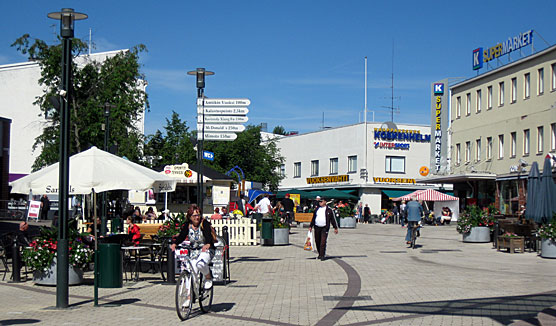Press release 2013-10-25 at 9:59
In Finland, urban regions have undergone significant changes in the past few decades. This is revealed by a recently completed research report by the Finnish Environment Institute SYKE. The report is a comprehensive account of the trends in urbanisation and the aspects that must be taken into account in sustainable urban planning in Finland. The research results will be published in Helsinki today, 25 October 2013.

|
|
Pedestrian zone in Imatra. Image: Panu Söderström / SYKE
|
The research report describes the development of the urban structure of 34 Finnish urban regions over the past 25 years. The report studies, amongst other things, the placement of housing and workplaces, and the population's travel behaviour at different times. The results are based on extensive data and a new international theory of urban fabrics. The research report studies urban regions as pedestrian, transit and car-oriented zones.
“One of the most significant planning challenges in recent years has been the integration of land use and transport. The new theory enables us to analyse, much more effectively than before, the harmful and beneficial effects of different planning solutions. The aim is to put the results of our report into practice broadly in urban planning in different parts of Finland,” says Senior Research Scientist Mika Ristimäki from SYKE.
Future scenarios to be published in the winter
“The study reveals, for instance, the trend in population ageing in Finnish urban regions in recent decades. Results indicate that over 74-year-olds are looking to live in city centres and subcentres. In some subcentres in the Tampere urban region, for instance, those aged over 74 already constitute up to one-quarter of the inhabitants. For the time being, this change in age structure has not been sufficiently taken into account in planning of urban regions”, Ristimäki points out.
The new report on the development of urban form in Finland is based on a joint project between SYKE and Tampere University of Technology. At present, the project is analysing the most significant changes in the urban form and trends up to 2030. Future scenarios will be published next winter.
Seminar brings top experts together
The publishing event of the report Travel-related Urban Zones in Finland forms part of an international seminar taking place in Helsinki. This week, the event brought together almost one hundred European experts in urban form, who are members of the European Union's COST technology network.
The seminar’s keynote speaker, Australian Professor Peter Newman is a pioneer in sustainable urban planning, and is, for instance, the transport specialist on the IPCC, the Intergovernmental Panel on Climate Change. Prof. Newman presented the new theory of urban fabrics now for the first time in Europe, together with Leo Kosonen, Senior Research Scientist at SYKE.
Seminar material:
Further information
Senior Research Scientist Mika Ristimäki, Finnish Environment Institute SYKE, tel. +358 400 148 842, firstname.lastname@environment.fi
Communications
Information Officer Anna Toppari, Finnish Environment Institute SYKE, tel. +358 40 674 8393, firstname.lastname@environment.fi
Photos for media
The share of population over 74 years has increased the most in the peri-urban centres, such as Kangasala or Nokia, the share soon reaching 25 percent of their population. The trend for centre of Tampere has been opposite - the share of the elderly is decreasing. In the outer urban subcentres, such as Hervanta or Pirkkala, the share has also been on the increase, but it is still below the average of all the centres in Tampere. © SYKE/YKR
Image: Panu Söderström / SYKE